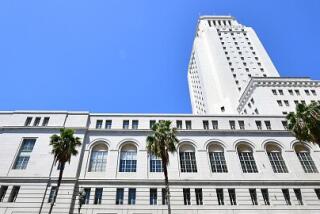Tire Firm Assessed Damages in Crash
- Share via
In what might be the largest verdict involving a tire blowout, a Los Angeles jury ordered Continental General Tire on Friday to pay damages of nearly $55.4 million for a defect that caused a rollover crash that left a young woman a quadriplegic.
After eight days of deliberations, the jury in Los Angeles Superior Court awarded the damages to Cynthia Lampe, 33, who was paralyzed from the neck down in the June 1996 crash, and her mother and father. The verdict is believed to be the largest in history involving tread-separation failure, a danger that came to prominence last year with the recall of Firestone tires that were implicated in scores of fatal rollover wrecks.
The verdict, which climaxed a nearly three-month trial, came a day after another big tire verdict in El Paso, Texas, in which Cooper Tire and Rubber Co. was ordered pay $9.74 million to the families of four people who died when the treads peeled from a tire, causing their minivan to flip over.
Lampe and her mother, Sylvia Cortez, expressed joy at the outcome. Lampe said she was very excited and happy the trial exposed “what General Tire is all about.”
“I’m just very glad that it’s finally over,” said Cortez, who was also injured in the accident, though not severely. Her daughter’s injuries have had “a tremendous impact on all of us,” Cortez said, “but thank God we’re a close-knit family, and we’ll start healing from now on.”
Continental General is the U.S. unit of Continental AG of Germany, the world’s fourth-largest tire manufacturer. In a statement issued after the verdict, the company said it was “deeply disappointed and will appeal.”
The company said the 15-inch AmeriTech ST tire that was the focus of the case was one of 4.6 million it had produced for Ford Taurus and Mercury Sable cars, had been driven nearly 50,000 miles, and therefore “could not have been defective.”
“Ms. Lampe experienced a tragic accident and we are deeply sympathetic to her plight,” the company said. “But our tire was not the cause of this tragedy.”
The verdict may cement Los Angeles’ image as a risky place to defend personal injury cases involving tire and automotive defects. The largest civil verdict in U.S. history--a $4.9-billion award against General Motors--came in 1999 in a vehicle fire case in Los Angeles Superior Court--an award later trimmed by the judge to $1.2 billion and now on appeal. Brian Panish, one of the Lampe lawyers, represented plaintiffs in the GM case.
Despite Friday’s award, jurors rejected some of Lampe’s case, including claims that the tire was defectively designed. The jury also refused to award punitive damages because the tire maker had not acted with malice.
But the panel ruled unanimously that the company had been negligent, and that the tire contained a manufacturing defect.
The trial “exposed the fact that they had a manufacturing process that put profits ahead of safety,” said Taras Kick, one of the Lampe attorneys.
Bruce Kaster, a Florida lawyer who has handled dozens of tire suits, said the Lampe case and others have shown that quality controls in many tire plants are woefully inadequate.
Lampe’s lawyers presented damaging testimony from former workers at the Mount Vernon, Ill., plant where the Lampe tire was made in December 1992.
The workers described intense production pressures and said it was not unusual for floor sweepings and other contaminants to be dumped in the rubber mix.
Jurors were also shown a memo by an operations manager at the Mount Vernon plant. “We are out of control,” said the 1993 memo, “and as you can see, it is not one particular defect, but a conglomeration from every department.”
Plaintiffs also produced evidence of severe quality problems involving tires produced by Continental General for Big O Tires, a major distributor, from the late 1980s to early ‘90s.
Lampe was heading to Las Vegas on Interstate 15 when the tread suddenly separated from her left rear tire. The ’93 Ford Taurus veered off the highway and up an embankment, then flipped over. Lampe, then 28, suffered a broken neck.
Her lawyers argued that contaminants in the tire’s rubber weakened the adhesion between its steel belts, causing them to pull apart and peel the tread away.
Defense lawyers countered that the tire had been well-made, but had suffered prior road damage that weakened the bond between the belts. And they said that despite the blowout, Lampe should have been able to bring the car under control, and thus was at fault.
The argument, standard in the defense of tire cases, was flatly rejected by the jury, which refused to assign even 1% of the fault to Lampe.
It was “merely an attempt to shift blame, and it’s clearly not reality in these violent, sudden tread separations,” Panish said. “The victims have no warning or opportunity to prevent loss of control of the vehicle.”
All told, the jury awarded nearly $49.9 million in compensatory damages to Lampe and more than $4.5 million to her mother. Her father Joe Cortez, a prominent boxing referee, was also awarded $1 million in damages.
Defense lawyer Walter Yoka said the AmeriTech ST tires had a fine safety record, and that plaintiffs had failed to show that product quality had suffered from alleged manufacturing lapses. Therefore, he said, such evidence should have been excluded from the trial.
The plaintiffs previously had reached a $4.09-million settlement with three other defendants: Ford Motor Co.; a Sears, Roebuck and Co. service center that had inspected the Taurus before the ill-fated trip; and the dealership that sold the used car to the Cortez family.






